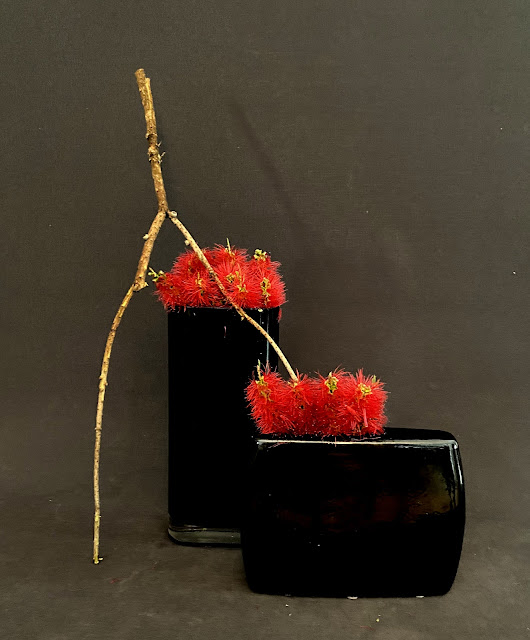Hello all,
My spring garden is continuing to delight me. My pink dogwood (Cornus Florida rubra) was in full flower for the first time this year and I dared to cut two stems to bring inside. Apart from some trimming and securing the branches in the container, I did not need to do anything else.
Also, my mollis azalea avocet is pure perfection. The contrast of the delicate, white and yellow flowers against the lime green leaves is quite charming.
Last Saturday's Masterclass was particularly challenging. I had provided each participant with only one, rather large branch of red callistemon and two containers. I asked them to be creative and to think outside the square. Having only one material to work with to create an interesting arrangement is not easy but the girls rose to the challenge and made me proud.
As always, I too, took the challenge with an arrangement but forgot to photograph it.
Lei cut down her branch and selected two side shoots with interesting shapes. She removed almost all of the leaves allowing the stems to be featured.
Christine, needing extra height, placed one vase on top of the other, then draped two stems of the callistemon over them.
Lucy separated the side shoots which had only buds and draped them over one vase then placed four flowers, vertically, through a slit in the second container.
Cymbie placed her branches up side down and, then, proceeded to wire flowers and buds giving them a rather unnatural but interesting direction.
Vicky's arrangement was reminiscent of the lesson 'Disassembling and Rearranging the Material'. She removed flowers, buds and leaves from the branch and placed the flowers in her two containers. She then used the 'stick' to add a line.
I leave you with this arrangement that I took to my friend, Merryl's place on Friday, when I went there for lunch. We are a group of four friends who met at our children's high school, helping out at the tuck shop. We call ourselves 'The Tuck Shop Girls'. (We sound like a girl band!) We have maintained our friendship ever since by meeting 3 or 4 times a year for lunch at alternating houses. These are marathon lunches which last a minimum of seven hours. Surprisingly, we never run out of things to say.
I chose the green goddess lilies for this arrangement for their longevity and, wired the way I had them, they are easy to transport. The wisteria vine is fresh, so in about a week or so, it should sprout leaves. To cover my mechanics, I used baby tears (soleirolia).
Bye for now'
Emily




















































